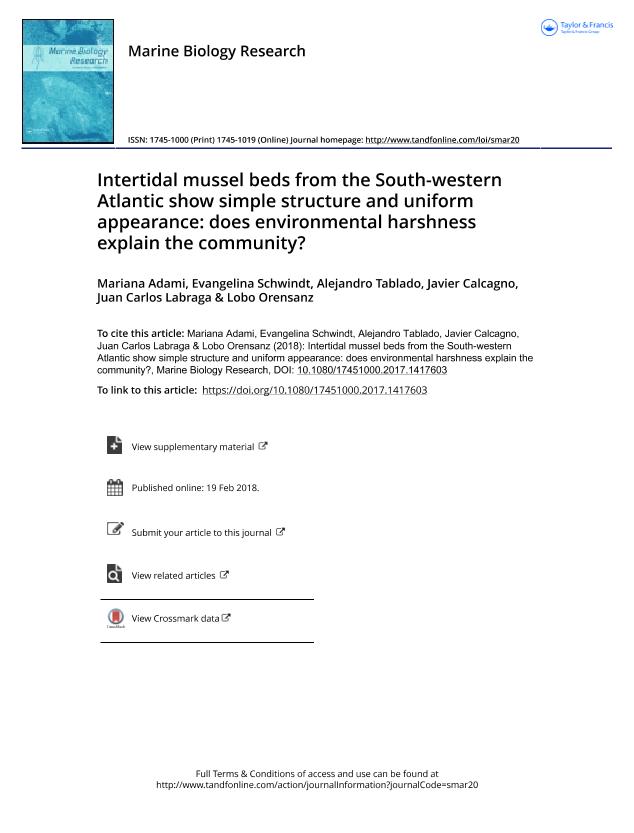Mostrar el registro sencillo del ítem
dc.contributor.author
Adami, Mariana Laura

dc.contributor.author
Schwindt, Evangelina

dc.contributor.author
Tablado, Alejandro

dc.contributor.author
Calcagno, Javier Ángel

dc.contributor.author
Labraga, Juan Carlos

dc.contributor.author
Orensanz, Jose Maria

dc.date.available
2018-12-04T21:24:54Z
dc.date.issued
2018-04
dc.identifier.citation
Adami, Mariana Laura; Schwindt, Evangelina; Tablado, Alejandro; Calcagno, Javier Ángel; Labraga, Juan Carlos; et al.; Intertidal mussel beds from the South-western Atlantic show simple structure and uniform appearance: does environmental harshness explain the community?; Taylor & Francis As; Marine Biology Research; 14; 4; 4-2018; 403-419
dc.identifier.issn
1745-1000
dc.identifier.uri
http://hdl.handle.net/11336/65815
dc.description.abstract
Communities of the rocky mid-intertidal zone of the South-western Atlantic are uniform in appearance, dominated by dense monocultures of small-size mussels (Brachidontes rodriguezii and Perumytilus purpuratus). To explain this, two hypotheses have been advanced in the literature: environmental harshness due to high potential evaporation and historical contingency after the Last Glacial Maximum. In this study of Uruguayan and Argentine shores, we address the implications and predictions of these two hypotheses from a biogeographic perspective by studying the regional distribution and composition of mid-intertidal mussels. We conducted an extensive latitudinal sampling survey (21 locations, 34–54°S), along with a compilation of available information on mussel bed composition and mussel predators present along the coastline. Then we constructed latitudinal profiles of ecologically significant environmental variables with specific emphasis on potential evaporation, a proxy for desiccation stress. The results show that mussel beds are composed of two species of small mussels, which coexist over a biogeographic transition zone (40–42°S) related to sea surface water temperature. The distribution of mussels along the coastline studied is not consistent with the environmental harshness hypothesis. In addition, in the Central Patagonian zone (44–50°S), two invertebrate predators also inhabit the intertidal rocky shores. However, these localities showed higher environmental harshness (potential evaporation rate) than non-Patagonian localities. We suggest that further attention should be given to historical contingency in order to advance towards a hypothesis consistent with current knowledge on the post-glacial biogeographic history of the South-western Atlantic.
dc.format
application/pdf
dc.language.iso
eng
dc.publisher
Taylor & Francis As

dc.rights
info:eu-repo/semantics/openAccess
dc.rights.uri
https://creativecommons.org/licenses/by-nc-sa/2.5/ar/
dc.subject
Historical Contingency
dc.subject
Mussel Bed
dc.subject
South-Western Atlantic
dc.subject
Stress
dc.subject.classification
Otras Ciencias Biológicas

dc.subject.classification
Ciencias Biológicas

dc.subject.classification
CIENCIAS NATURALES Y EXACTAS

dc.title
Intertidal mussel beds from the South-western Atlantic show simple structure and uniform appearance: does environmental harshness explain the community?
dc.type
info:eu-repo/semantics/article
dc.type
info:ar-repo/semantics/artículo
dc.type
info:eu-repo/semantics/publishedVersion
dc.date.updated
2018-10-23T19:53:06Z
dc.journal.volume
14
dc.journal.number
4
dc.journal.pagination
403-419
dc.journal.pais
Reino Unido

dc.journal.ciudad
Londres
dc.description.fil
Fil: Adami, Mariana Laura. Consejo Nacional de Investigaciones Científicas y Técnicas; Argentina. Universidad Nacional de la Plata. Facultad de Ciencias Naturales y Museo. División Zoología Invertebrados; Argentina
dc.description.fil
Fil: Schwindt, Evangelina. Consejo Nacional de Investigaciones Científicas y Técnicas. Centro Científico Tecnológico Conicet - Centro Nacional Patagónico. Instituto de Biología de Organismos Marinos; Argentina
dc.description.fil
Fil: Tablado, Alejandro. Consejo Nacional de Investigaciones Científicas y Técnicas. Oficina de Coordinación Administrativa Parque Centenario. Museo Argentino de Ciencias Naturales “Bernardino Rivadavia”; Argentina
dc.description.fil
Fil: Calcagno, Javier Ángel. Consejo Nacional de Investigaciones Científicas y Técnicas; Argentina. Universidad Maimónides. Área de Investigaciones Biomédicas y Biotecnológicas. Centro de Estudios Biomédicos, Biotecnológicos, Ambientales y de Diagnóstico; Argentina
dc.description.fil
Fil: Labraga, Juan Carlos. Consejo Nacional de Investigaciones Científicas y Técnicas. Centro Nacional Patagónico; Argentina
dc.description.fil
Fil: Orensanz, Jose Maria. Consejo Nacional de Investigaciones Científicas y Técnicas. Centro Nacional Patagónico; Argentina
dc.journal.title
Marine Biology Research

dc.relation.alternativeid
info:eu-repo/semantics/altIdentifier/url/https://www.tandfonline.com/doi/abs/10.1080/17451000.2017.1417603?journalCode=smar20
dc.relation.alternativeid
info:eu-repo/semantics/altIdentifier/doi/https://dx.doi.org/10.1080/17451000.2017.1417603
Archivos asociados
